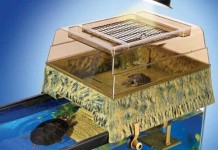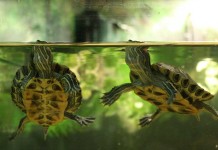Red eared sliders and lighting go hand-in-hand. When you keep a turtle as a pet, you can’t have on without the other. The sun is what makes life on this planet possible and every living thing on this planet requires the sun’s ultraviolet rays to some degree. Reptiles, in particular, make great use of ultraviolet rays to make vitamin D3 to metabolize calcium and keep their bones and shells hard and healthy.
Unless you are keeping your slider outside, therefore, you need to provide him with a regular source of UV rays. While it is recommended that you put your turtle out on warm, sunny days (to turtles, nothing beats the light of the sun), you need to have an ultraviolet-B fluorescent light, such as a Vita-lite ©. This is one of the most common and popular reptile lights on the market, so you shouldn’t have any problem finding one. These lights should be placed over your slider’s basking area so he can stretch out beneath it in the middle of the day and soak up the rays.
Another important light you need for your red eared slider is a heat lamp. Sliders need their ambient temperature to be at least 75 degrees Fahrenheit to keep their various systems, especially their immune system, operating at peak performance. Even if you keep your turtle in an area in which room temperature hovers around 75 degrees, you should keep a heat lamp handy at all times for emergencies. You never know when your area may have a sudden cold snap or your turtle may get sick, in which case he will require higher temperatures to better fight off the illness. Your heat lamp should also be placed near his basking area. The heat lamp should never be placed in such a way that your slider cannot get away from it if he wants to. Red eared sliders, being ectothermic, regulate their temperature by the ambient temperature. If your slider wants to go to the other side of the tank and cool down, he should be able to do so.
One mistake many first-time red eared sliders make is keeping the lighting on in the tank on at all times. While this is fine (and required) for the heat lamp, your turtle needs regular day and light cycles just like he was in the wild. In the wild he wouldn’t have 24-hour sunlight, so why keep his UV light on at all times? Turn his light on in the morning when you get up, and turn it off when the sun goes down. You can even get a light with a timer to do this for you!
Recommended: Combo Aquatic Turtle Lighting











